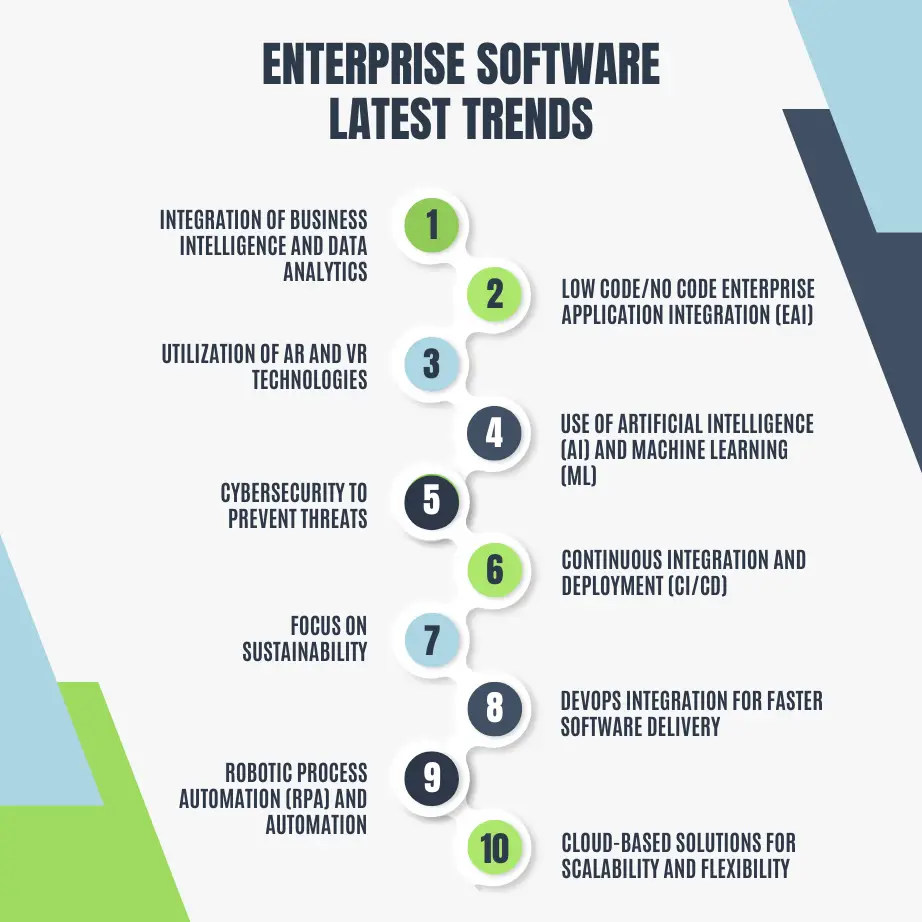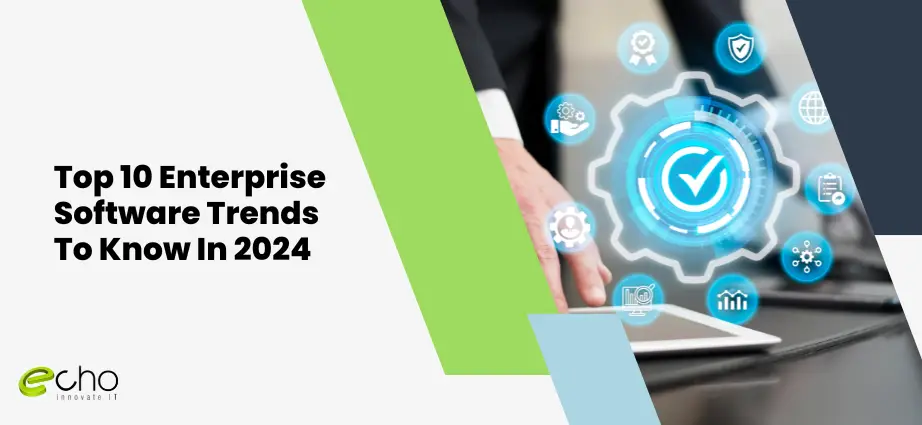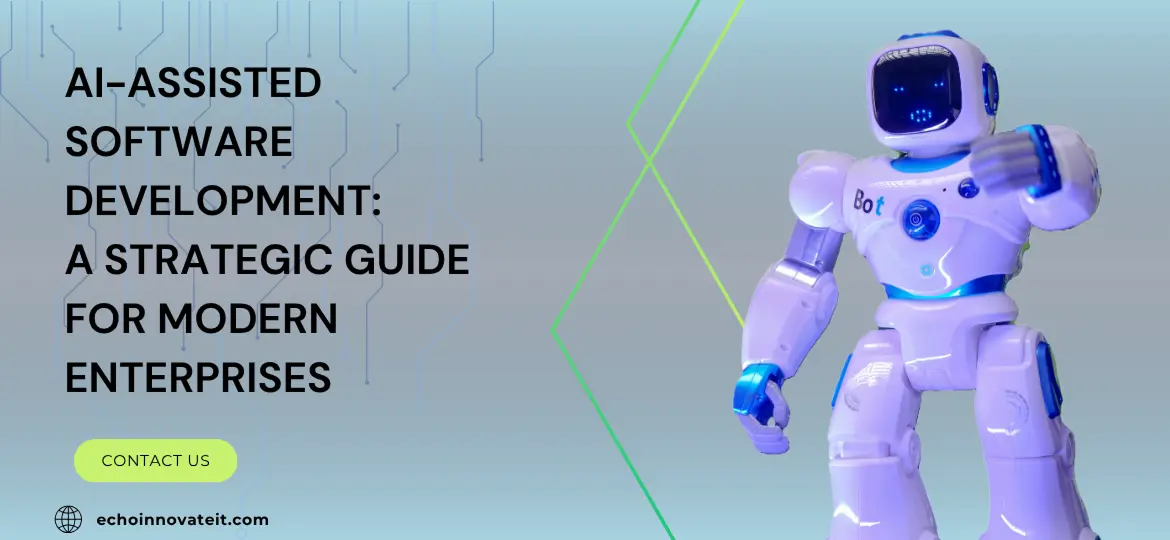Successful operations continuously adapt to change by leveraging cutting-edge technologies like ERP software to optimize efficiency. Enterprise resource planning (ERP) has gained significant traction in recent months as businesses seek to outperform competitors by relying on advanced enterprise resource planning software.
ERP solutions provide enhanced data consistency, improved processing capabilities, robust security features, and automation of deployment processes. By incorporating these innovations, companies can gain a competitive edge with enterprise resource planning (ERP) software. Understanding the latest trends in ERP software and other application software is crucial for businesses looking to stay ahead in the rapidly evolving software industry.
It’s hard to keep up with technology that’s moving and ever-evolving, especially in business. Keeping up with the latest trends is essential to stay competitive in today’s business landscape. Sometimes, the latest innovations can be absolutely useful. It can help startups reach higher efficiency, reduce errors, provide the ability to meet various customer expectations and unlock new possibilities. The only way to notice and profit from these changes is to adapt to new trends and stay current with innovations constantly.
As you must know, enterprise software development includes special applications and tools that manage enterprise structures and processes. It involves Enterprise Resource Planning (ERP), Customer Relationship Management (CRM), Enterprise Content Management (ECM), and other services that help companies work more efficiently on their projects.
With any advanced technology to make lives better, there comes an equal number of challenges. Enterprise software is complex, with ever-changing feature sets. Therefore, companies must adopt the latest trends and technologies to enhance scalability and optimize security to prevent malicious operations and preserve confidential data. With this, keeping up with futuristic trends in enterprise software development can reduce challenges such as compatibility issues, scalability, security threats, data integration, and inadequate user training.
Let’s read out the current growing market of enterprise software development and check out the top ten trends available in 2024 today.
Enterprise Software Market Size In 2024
As you know, the enterprise application software market is evolving rapidly due to technological advancements, so business owners must stay informed about the latest trends. Understanding the changes in enterprise app development before and after the COVID-19 pandemic highlights the importance of staying updated. Prior to the pandemic, businesses were already shifting to cloud computing and cloud-based ERP system software to enhance scalability, flexibility, and cost-efficiency.
Post-pandemic, with more companies adopting remote work, there has been a surge in demand for collaborative software solutions and efficient operations. This growth has accelerated the adoption of enterprise application solutions like project management tools, virtual collaboration software, and enterprise asset management software.
Now, let’s explore the latest technological trends shaping the future of ERP business solutions and enterprise application software. These innovations play a crucial role in supporting digital transformation and making enterprise systems more efficient and future-ready.
In this blog, we have curated the latest products and services designed to meet the needs of businesses across industries. These advancements in ERP systems and other enterprise technologies help businesses turn their ideas into reality and set them apart from the competition.
According to Statista, the market size of enterprise software will be USD 179.90 billion in 2024.
The revenue is growing year after year and is estimated to reach USD 218.80 billion in 2027.
According to the findings of Spherical Insights, the worldwide enterprise software market is anticipated to reach USD 519.88 billion by 2030.
The data suggests that following enterprise software development trends can benefit businesses by staying top in the competitive market for next coming years.

Integration Of Business Intelligence And Data Analytics
Modern enterprise resource planning (ERP) software often integrates built-in data analytics capabilities, allowing businesses to seamlessly transition from raw data to actionable insights. This integration reduces the need for separate application software, streamlining operations across the board.
In summary, combining ERP solutions with data analytics unlocks the full potential of your data, transforming it from unstructured information into valuable business intelligence.
By using ERP systems and BI tools, companies can make data-driven decisions that guide strategic planning, marketing initiatives, and product development. Data analytics within enterprise resource planning software reveals hidden patterns that may indicate future trends or new market opportunities. BI dashboards further empower businesses by tracking key metrics, identifying areas for improvement, and giving software industry companies a competitive edge.
Low Code/No Code Enterprise Application Integration (EAI)
Businesses are adopting low-code or no-code development because it enables non-technical individuals to design customized applications with little to no coding skills. As a result, when building or improving enterprise systems, businesses should ensure that users have access to low- or no-code development tools.
This allows users or customers to create customized procedures and services based on their specific needs. Suppose you are in the process of providing personalized applications. In that case, a full-fledged custom app development company like Echoinnovate IT can help you enhance your applications and make your app development journey better.
The minimal code or no code development technique allows business owners or subject matter experts to swiftly experiment with new ideas and enhancements without committing the time and energy of an experienced developer. Companies can enable users to modify the application and user interface, resulting in greater customization possibilities.
Utilization Of AR And VR Technologies
AR and VR technology are being used to enhance human talents in the workplace. For example, AR can be used to give workers hands-free access to information and instructions, whilst VR can be utilized to train workers in a safe and realistic setting.
As AR and VR technology advance, we may expect more inventive workplace uses. Brain-computer interfaces and advanced wearables have the potential to erase the distinction between the physical and digital worlds, ushering in a future in which human skills are seamlessly enhanced by technology.
Use Of Artificial Intelligence (AI) And Machine Learning (ML)
Artificial Intelligence (AI) and Machine Learning (ML) are updating company operations by automating difficult procedures, filtering critical values from massive databases, and boosting decision-making abilities. You may utilize AI and machine learning to accelerate the development of data-driven applications and create interesting user experiences. Machine learning algorithms will continuously learn, adapt, and improve over time based on the data and information collected from consumers.
Integrating AI and Machine Learning models into workplace software provides intelligent chatbots for fast interactions, AI-based suggestions for a more personalized user experience, and market trend predictions. The integration of AI and machine learning will allow for smoother operations, the automation of repetitive processes, and an increase in innovation.
Also Check:
Cybersecurity To Prevent Threats
Traditional security has a perimeter-based approach, granting access only once users are within the network. Zero-trust assumes that everyone and everything is a potential danger, constantly checking access requests regardless of location or device. This includes features such as multi-factor authentication (MFA) and ongoing monitoring of user activities to detect suspicious behaviour.
Proactive defence is critical in today’s cybersecurity scenario. Threat intelligence is obtaining and analyzing information about present and emerging cyber threats. In an ever-changing threat landscape, enterprises may greatly improve their cybersecurity posture by implementing a complete approach that includes advanced security features, continuous vigilance, and user education.
Continuous Integration And Deployment (CI/CD)
Continuous integration and continuous delivery/deployment (CI/CD) are key practices in modern software development. There are numerous CI/CD tools available, including Jenkins, GitLab CI/CD, CircleCI, and AWS CodePipeline. These tools help to automate the build, test, and deployment processes, making it easier for teams to develop CI/CD pipelines.
CI/CD is not a one-size-fits-all solution, and the specific implementation will depend on the organization’s requirements. However, it is an effective strategy that can considerably improve the software development lifecycle.
Focus On Sustainability
Sustainability is a big topic in corporate software that is only gaining popularity. The software can track energy consumption across many sites, finding regions of high demand. Businesses can monitor their carbon footprint throughout the supply chain, including emissions from transportation, production, and energy use.
Waste management software tracks waste generation, disposal options, and costs.
This assists organizations in identifying possibilities to decrease waste, such as introducing recycling programs or adopting more environmentally friendly packaging materials.
By applying these solutions, businesses can drastically minimize their environmental impact, boost their brand image, and even save money on energy and waste management.
DevOps Integration For Faster Software Delivery
In 2024, several enterprise software trends will revolve around DevOps integration. Platform engineers use Infrastructure as Code (IaC) to manage and deploy infrastructure in a consistent, automated manner. We are a top DevOps development company actively helping businesses integrate the latest enterprise software trends for the fastest delivery of products.
Integrating security best practices throughout the development process (DevSecOps) is critical for enterprise software. DevOps technologies and techniques can be used to automate security testing and incorporate security concerns into CI/CD pipelines.
DevOps integration is no longer a standalone technique but rather an essential component of the modern enterprise software development landscape. Organizations that embrace DevOps ideas and technologies can maximize the promise of these new trends, resulting in speedier innovation, increased efficiency, and better agility.
Robotic Process Automation (RPA) And Automation
When it comes to modernizing enterprise applications, one of the most crucial subjects to understand is robotic process automation or RPA. RPA solutions can automate rule-based and repetitive activities by emulating human-to-software interactions. It has been shown that robotic process automation can improve operational efficiency in enterprises. Employees will save time overall because automated activities lower the likelihood of human error.
RPA can be used for data entry, invoice processing, report production, workflow automation, and data extraction. Furthermore, as more businesses seek to reduce labour-intensive business processes, the number of RPA use cases and adoption will grow in the years ahead.
Cloud-Based Solutions For Scalability And Flexibility
Enterprise application software will evolve rapidly to meet the changing needs and expectations of customers. This evolution will enhance the functionality of various industries.
As businesses choose to digitize their operations, transitioning to the cloud becomes essential and the most viable solution for data storage. However, these transitions come with new expectations, which necessitate the adoption of modern cloud technologies and robust security features.
Consequently, cloud computing is set to become the leading trend in enterprise software development, particularly within ERP applications and enterprise resource management software. Moreover, this shift will also enhance the capabilities of enterprise project management software, enabling organizations to manage projects more efficiently and securely in the cloud.
Conclusion
Ready to take the ultimate advantage of these latest software trends in 2024? Implementing and adapting such changes is not a choice but a necessity to thrive in the ever-evolving environment of technology. With this, our top 10 trends mentioned above play a pivotal role in shaping the future of enterprise software.
From business intelligence, use of AI and ML, DevOps integration, Low code/No code, AR/VR technologies, cybersecurity and focus on sustainability will help in the growth and higher productivity of enterprises. By adding these innovations to one’s business, companies can stay ahead in the era of competitive digital age.
FAQs- Top 10 Enterprise Software Trends To Know In 2024
What are the top enterprise software trends for 2024?
In 2024, some of the key enterprise software trends include increased adoption of AI and machine learning, the rise of low-code/no-code platforms, enhanced cybersecurity measures, the growth of edge computing, and greater emphasis on data privacy and compliance.
How is AI transforming enterprise software in 2024?
AI is revolutionizing enterprise software by enabling advanced analytics, automating routine tasks, enhancing decision-making processes, and improving customer experiences through personalized services and chatbots.
Why are low-code/no-code platforms trending in enterprise software?
Low-code/no-code platforms are trending because they empower non-technical users to create and customize applications quickly and cost-effectively, reducing dependency on IT departments and accelerating digital transformation initiatives.
What role does edge computing play in enterprise software in 2024?
Edge computing is crucial in 2024 as it allows data processing closer to the source of data generation, reducing latency, improving real-time data analysis, and enhancing the performance of IoT devices and applications in sectors like manufacturing and healthcare.



